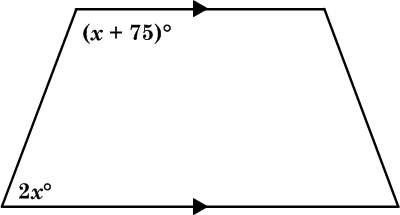
Mathematics, 01.12.2019 04:31 teagan56
Part a
which solution for the value of x in the figure is incorrect?
2x = x + 75
x = 75
2x + x + 75 = 180
3x + 75 = 180
3x = 105
x = 35
(1 point)
solution a is incorrect. solution b is incorrect. both solutions are incorrect. neither solution is incorrect.
part b
which reason could you give to explain your answer to the previous item?
(1 point)
the labeled angles are corresponding angles, which are congruent. congruent angles have equal measures, so x + 75 should be set equal to 2x, not added to 2x and set equal to 180.the labeled angles are alternate interior angles, which are congruent. congruent angles have equal measures, so x + 75 should be set equal to 2x, not added to 2x and set equal to 180.the labeled angles are same-side interior angles, which are supplementary. the measures of supplementary angles total 180 degrees, so x + 75 plus 2x should be set equal to 180. the angle measures should not be set equal to each other. the labeled angles are a linear pair, which mean that they are supplementary. the measures of supplementary angles total 180 degrees, so x + 75 plus 2x should be set equal to 180. the angle measures should not be set equal to each other.


Answers: 2
Another question on Mathematics

Mathematics, 21.06.2019 14:20
What is the point-slope form of the equation for the line with a slope of -2 that passes through (1,4)?
Answers: 1

Mathematics, 21.06.2019 18:40
Juliana says that she can use the patterns of equivalent ratios in the multiplication table below to write an infinite number of ratios that are equivalent to 6: 10. which statement explains whether juliana is correct? she is correct because she can multiply 6 and 10 by any number to form an equivalent ratio. she is correct because 6: 10 can be written as 1: 2 and there are an infinite number of ratios for 1: 2. she is not correct because the multiplication table does not include multiples of 10. she is not correct because 6: 10 is equivalent to 3: 5 and there are only 9 ratios in the multiplication table that are equivalent to 3: 5.
Answers: 1

Mathematics, 21.06.2019 19:20
1- what do you think the product of a nonzero rational number and an irrational number is? is it rational or irrational? make use of variables, the closure property of integers, and possibly a proof by contradiction to prove your hypothesis.2- why do we have to specify that the rational number must be nonzero when we determine what the product of a nonzero rational number and an irrational number is? if the rational number were 0, would it give us the same result we found in the first question?
Answers: 2

You know the right answer?
Part a
which solution for the value of x in the figure is incorrect?
2x =...
which solution for the value of x in the figure is incorrect?
2x =...
Questions


Chemistry, 23.05.2021 22:30

Mathematics, 23.05.2021 22:30

Mathematics, 23.05.2021 22:30

Mathematics, 23.05.2021 22:30



Mathematics, 23.05.2021 22:30




Mathematics, 23.05.2021 22:30

Mathematics, 23.05.2021 22:30

Mathematics, 23.05.2021 22:30





English, 23.05.2021 22:30

Mathematics, 23.05.2021 22:30



